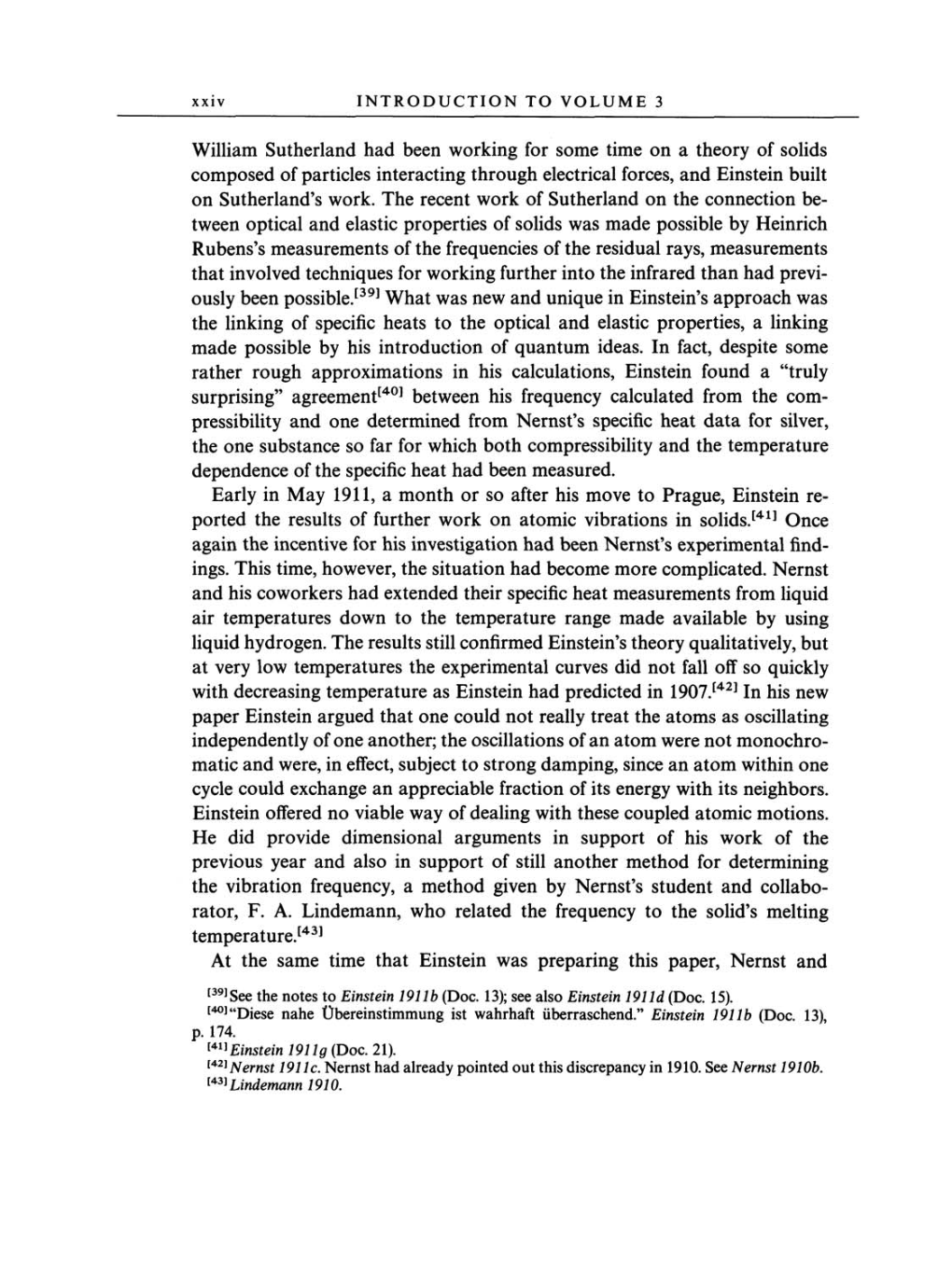xxiv INTRODUCTION TO
VOLUME
3
William Sutherland
had been
working
for
some
time
on a
theory
of solids
composed
of
particles interacting
through
electrical
forces,
and Einstein built
on
Sutherland's
work. The
recent
work of Sutherland
on
the connection
be-
tween
optical
and elastic
properties
of
solids
was
made
possible by
Heinrich
Rubens's measurements
of
the
frequencies
of
the
residual
rays,
measurements
that
involved
techniques
for
working
further into the infrared
than
had
previ-
ously
been
possible.[39]
What
was new
and
unique
in Einstein's
approach
was
the
linking
of
specific
heats
to
the
optical
and elastic
properties,
a
linking
made
possible by
his
introduction of
quantum ideas.
In
fact,
despite
some
rather
rough
approximations
in his
calculations,
Einstein found
a
"truly
surprising"
agreement[40]
between
his
frequency
calculated from the
com-
pressibility
and
one
determined from Nernst's
specific
heat
data
for
silver,
the
one
substance
so
far for which
both
compressibility
and the
temperature
dependence
of
the
specific
heat had been measured.
Early
in
May 1911,
a
month
or so
after his
move
to
Prague,
Einstein
re-
ported
the results of further work
on
atomic vibrations in
solids.[41] Once
again
the incentive for his
investigation
had been Nernst's
experimental
find-
ings.
This
time, however,
the situation had become
more
complicated.
Nernst
and his coworkers had extended their
specific
heat
measurements
from
liquid
air
temperatures
down
to
the
temperature range
made available
by using
liquid hydrogen.
The results still confirmed Einstein's
theory qualitatively,
but
at
very
low
temperatures
the
experimental
curves
did
not fall off
so
quickly
with
decreasing
temperature
as
Einstein had
predicted
in
1907.[42]
In
his
new
paper
Einstein
argued
that
one
could not
really
treat
the
atoms
as oscillating
independently
of
one
another;
the oscillations of
an
atom
were
not
monochro-
matic and
were,
in
effect, subject
to
strong damping,
since
an
atom
within
one
cycle
could
exchange an appreciable
fraction of
its
energy
with
its
neighbors.
Einstein
offered
no
viable
way
of
dealing
with these
coupled
atomic
motions.
He did
provide
dimensional
arguments
in
support
of his work of
the
previous year
and also
in
support
of
still
another
method for
determining
the vibration
frequency,
a
method
given by
Nernst's student and collabo-
rator,
F.
A. Lindemann,
who related the
frequency
to
the solid's
melting
temperature.[43]
At the
same
time
that
Einstein
was
preparing
this
paper,
Nernst and
[39]See
the
notes
to
Einstein
1911b (Doc.
13);
see
also Einstein
1911d
(Doc.
15).
[40]"Diese
nahe
Übereinstimmung
ist wahrhaft überraschend." Einstein
1911b
(Doc.
13),
p.
174.
[41]Einstein
1911g
(Doc.
21).
[42]Nernst
1911c.
Nernst had
already pointed
out
this
discrepancy
in
1910. See
Nernst
1910b.
[43]Lindemann
1910.
